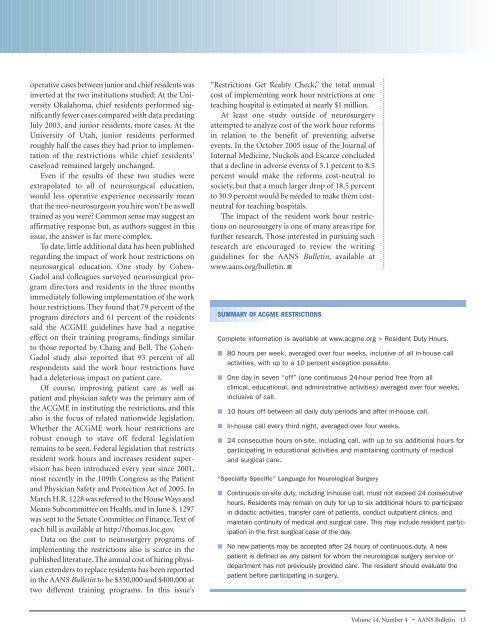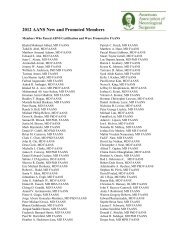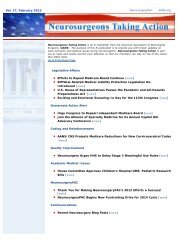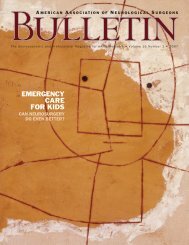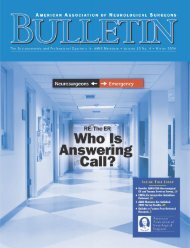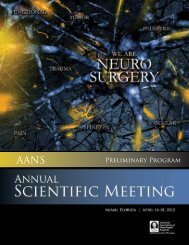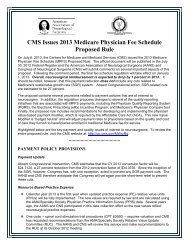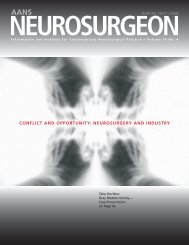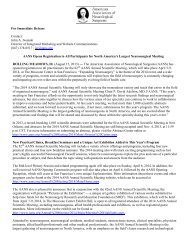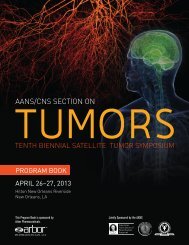view PDF - American Association of Neurological Surgeons
view PDF - American Association of Neurological Surgeons
view PDF - American Association of Neurological Surgeons
You also want an ePaper? Increase the reach of your titles
YUMPU automatically turns print PDFs into web optimized ePapers that Google loves.
operative cases between junior and chief residents was<br />
inverted at the two institutions studied: At the University<br />
Okalahoma, chief residents performed significantly<br />
fewer cases compared with data predating<br />
July 2003, and junior residents, more cases. At the<br />
University <strong>of</strong> Utah, junior residents performed<br />
roughly half the cases they had prior to implementation<br />
<strong>of</strong> the restrictions while chief residents’<br />
caseload remained largely unchanged.<br />
Even if the results <strong>of</strong> these two studies were<br />
extrapolated to all <strong>of</strong> neurosurgical education,<br />
would less operative experience necessarily mean<br />
that the neo-neurosurgeon you hire won’t be as well<br />
trained as you were Common sense may suggest an<br />
affirmative response but, as authors suggest in this<br />
issue, the answer is far more complex.<br />
To date, little additional data has been published<br />
regarding the impact <strong>of</strong> work hour restrictions on<br />
neurosurgical education. One study by Cohen-<br />
Gadol and colleagues surveyed neurosurgical program<br />
directors and residents in the three months<br />
immediately following implementation <strong>of</strong> the work<br />
hour restrictions. They found that 79 percent <strong>of</strong> the<br />
program directors and 61 percent <strong>of</strong> the residents<br />
said the ACGME guidelines have had a negative<br />
effect on their training programs, findings similar<br />
to those reported by Chang and Bell. The Cohen-<br />
Gadol study also reported that 93 percent <strong>of</strong> all<br />
respondents said the work hour restrictions have<br />
had a deleterious impact on patient care.<br />
Of course, improving patient care as well as<br />
patient and physician safety was the primary aim <strong>of</strong><br />
the ACGME in instituting the restrictions, and this<br />
also is the focus <strong>of</strong> related nationwide legislation.<br />
Whether the ACGME work hour restrictions are<br />
robust enough to stave <strong>of</strong>f federal legislation<br />
remains to be seen. Federal legislation that restricts<br />
resident work hours and increases resident supervision<br />
has been introduced every year since 2001,<br />
most recently in the 109th Congress as the Patient<br />
and Physician Safety and Protection Act <strong>of</strong> 2005. In<br />
March H.R. 1228 was referred to the House Ways and<br />
Means Subcommittee on Health, and in June S. 1297<br />
was sent to the Senate Committee on Finance. Text <strong>of</strong><br />
each bill is available at http://thomas.loc.gov.<br />
Data on the cost to neurosurgery programs <strong>of</strong><br />
implementing the restrictions also is scarce in the<br />
published literature. The annual cost <strong>of</strong> hiring physician<br />
extenders to replace residents has been reported<br />
in the AANS Bulletin to be $350,000 and $400,000 at<br />
two different training programs. In this issue’s<br />
“Restrictions Get Reality Check,” the total annual<br />
cost <strong>of</strong> implementing work hour restrictions at one<br />
teaching hospital is estimated at nearly $1 million.<br />
At least one study outside <strong>of</strong> neurosurgery<br />
attempted to analyze cost <strong>of</strong> the work hour reforms<br />
in relation to the benefit <strong>of</strong> preventing adverse<br />
events. In the October 2005 issue <strong>of</strong> the Journal <strong>of</strong><br />
Internal Medicine, Nuckols and Escarce concluded<br />
that a decline in adverse events <strong>of</strong> 5.1 percent to 8.5<br />
percent would make the reforms cost-neutral to<br />
society, but that a much larger drop <strong>of</strong> 18.5 percent<br />
to 30.9 percent would be needed to make them costneutral<br />
for teaching hospitals.<br />
The impact <strong>of</strong> the resident work hour restrictions<br />
on neurosurgery is one <strong>of</strong> many areas ripe for<br />
further research. Those interested in pursuing such<br />
research are encouraged to re<strong>view</strong> the writing<br />
guidelines for the AANS Bulletin, available at<br />
www.aans.org/bulletin. 3<br />
SUMMARY OF ACGME RESTRICTIONS<br />
Complete information is available at www.acgme.org > Resident Duty Hours.<br />
3 80 hours per week, averaged over four weeks, inclusive <strong>of</strong> all in-house call<br />
activities, with up to a 10 percent exception possible.<br />
3 One day in seven “<strong>of</strong>f” (one continuous 24-hour period free from all<br />
clinical, educational, and administrative activities) averaged over four weeks,<br />
inclusive <strong>of</strong> call.<br />
3 10 hours <strong>of</strong>f between all daily duty periods and after in-house call.<br />
3 In-house call every third night, averaged over four weeks.<br />
3 24 consecutive hours on-site, including call, with up to six additional hours for<br />
participating in educational activities and maintaining continuity <strong>of</strong> medical<br />
and surgical care.<br />
“Specialty Specific” Language for <strong>Neurological</strong> Surgery<br />
3 Continuous on-site duty, including in-house call, must not exceed 24 consecutive<br />
hours. Residents may remain on duty for up to six additional hours to participate<br />
in didactic activities, transfer care <strong>of</strong> patients, conduct outpatient clinics, and<br />
maintain continuity <strong>of</strong> medical and surgical care. This may include resident participation<br />
in the first surgical case <strong>of</strong> the day.<br />
3 No new patients may be accepted after 24 hours <strong>of</strong> continuous duty. A new<br />
patient is defined as any patient for whom the neurological surgery service or<br />
department has not previously provided care. The resident should evaluate the<br />
patient before participating in surgery.<br />
Volume 14, Number 4 • AANS Bulletin 13


